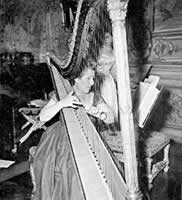Lily Laskine - 3 Concertos Pour Harp - 1964 - 1967seeders: 2
leechers: 0
Lily Laskine - 3 Concertos Pour Harp - 1964 - 1967 (Size: 218 MB)
Description
Registrazioni Storiche
 Lily Laskine - Concertos Pour Harp GEORG FRIEDRICH HAENDEL (1685-1759) (•) CONCERTO POUR HARPE OPUS 4 N° 6 Si bémol majeur / B flat major [1] Andante allegro 4'08 [2] Larghetto 6'08 [3] Allegro moderato 2'43 Total Time 13'05 FRANÇOIS JOSEPH GOSSEC (1734-1829) (•) SYMPHONIE CONCERTANTE POUR DEUX HARPES [4] Allegro 1'06 [5] Largo 3'53 [6] Rondo 6'40 Total Time 11'46 Odette Le DENTU. 2° harpe CARL REINECKE (1824-1910) CONCERTO POUR HARPE OPUS 182 [7] Allegro moderato 11'07 [8] Adagio 4'57 [9] Scherzo-Finale 7'26 Total Time 23'45 Lily LASKINE, harpe/harp ORCHESTRE DE CHAMBRE JEAN-FRANÇOIS PAILLARD (*) Direction/Conductor: Jean-François PAILLARD ORCHESTRE SYMPHONIQUE DE BAMBERG Direction/Conductor Theodor GUSCHLBAUER Enregistrement/Recording: 1964 (*) 1967 Remasterisation numérique/Digital remastering: 1988 ©Erato Disques S.A. 1965 (*), 1968 - Imprimé en France/Printed in France - Made in France   The daughter of Russian immigrants to Paris, harpist Lily Laskine was drawn into music by both parents. Her mother was a pianist, and she took up the piano at first. But she took more strongly to the harp, and soon she was practicing the instrument, at her mother's behest, for six hours a day. All one needs to play the harp, Laskine once said, is good fingers and a sacrificed childhood. At age eight, after some jawboning on her mother's part opened the doors, Laskine started lessons with Paris Conservatoire professor Alphonse Hasselmans, and three years later she enrolled at the venerable music school. By 1906 she had won the conservatory's top prize, and she formally embarked on her career at 13, never taking another harp lesson but continuing to absorb music and its lore throughout her life. What made Laskine a figure strongly identified with the harp over much of the world was her catholic interest in its entire literature, regardless of genre boundaries. She refused to be categorized as a recitalist and sought out opportunities to play wherever they might be found. In 1909, she became the first female member of the Paris Opéra Orchestra, on any instrument. She remained at the Opéra until 1926, also performing with concert series orchestras such as that of the Lamoureux Association and with an orchestra led by conductor Sergey Koussevitsky. In the 1930s Laskine made several European tours and began her recording career, which included both classical and popular releases. She was heard on records with Edith Piaf, Maurice Chevalier, and other greats of French popular song, and she contributed to many film scores. In 1979 she won the Grand Prix du Film Musical for her work on the score for La Leçon de Musique. A duet partner of French flutist Jean-Pierre Rampal for several decades, Laskine continued to perform and record until late in life. Several harp concertos were written for her, and she uncovered unknown historical works for harp such as Gossec's Symphonie concertante for two harps. Laskine served as professor of harp at the Conservatoire from 1948 to 1958, in which year she was made a Chevalier of the Legion of Honor. ~ James Manheim, Rovi Fonte Altre notizie  Content Lily Laskine - Concertos Pour Harp.ape Lily Laskine - Concertos Pour Harp.cue Lily Laskine - Concertos Pour Harp.log Cover001.jpg Cover002.jpg Dimensioni totali: 217 MB  Sharing Widget |